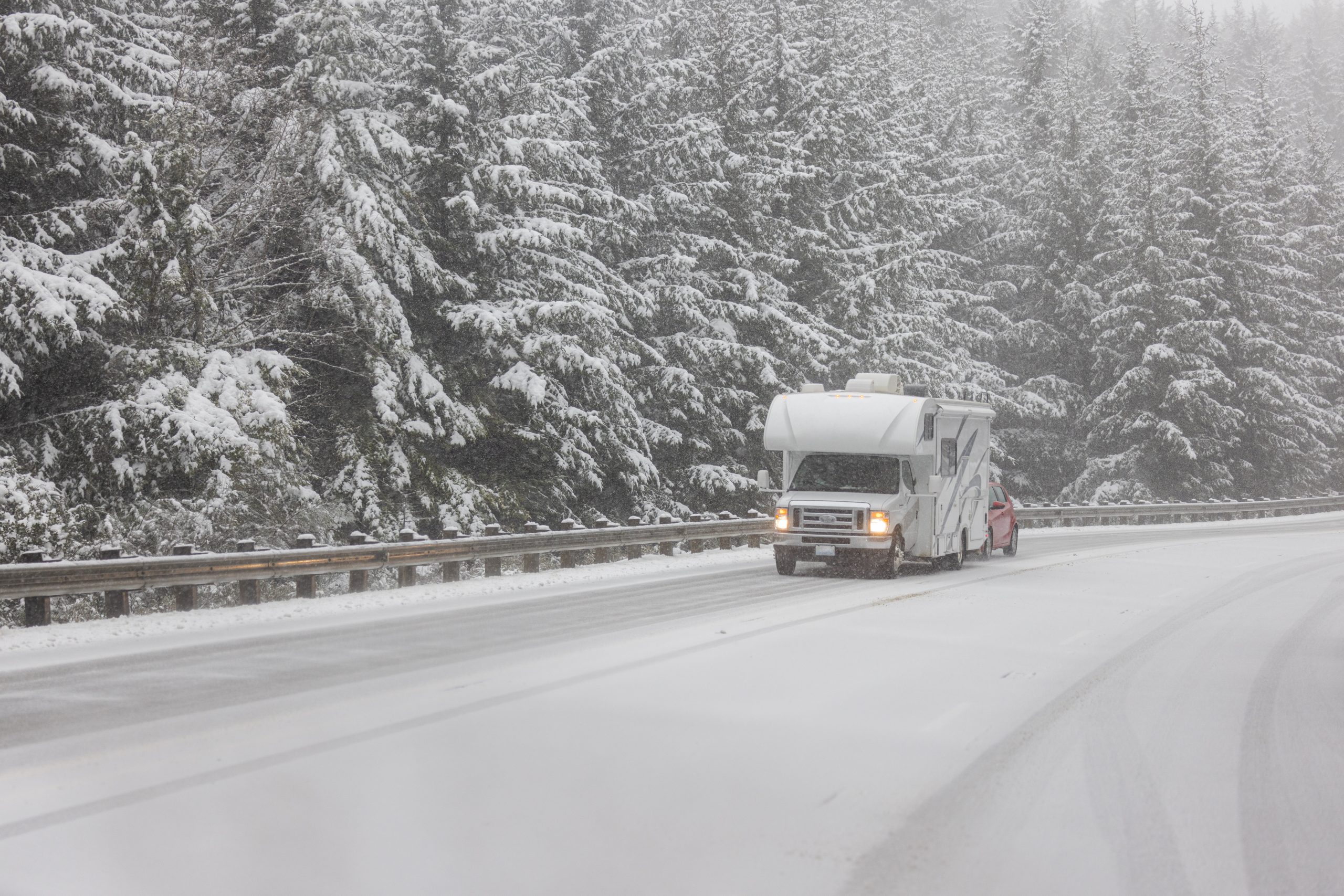Winter driving presents unique challenges for RV owners – especially when ice enters the equation. With their larger size, higher center of gravity, and increased weight, recreational vehicles require extra care on icy roads. According to national statistics, winter-related accidents cause over 1,800 deaths annually, with larger vehicles being particularly vulnerable due to their size and handling characteristics.
Before you embark on your winter RV adventure, let’s explore how to keep you and your home-on-wheels safe during icy conditions.
The Unique Challenges of RVs on Ice
Before hitting the road in winter conditions, ask yourself: Is this journey essential? Monitor weather advisories and road conditions carefully, as RVs face additional challenges compared to regular vehicles:
Size Matters
RVs have larger surface areas and longer wheelbases, making them more susceptible to crosswinds and reduced traction on icy surfaces. Their increased length also means more space is needed for safe maneuvering and stopping.
Weight Distribution
Even the most well-equipped RV can experience traction issues on ice. The distribution of weight in your RV – including water tanks, gear, and supplies – significantly affects handling in slippery conditions.
Height Concerns
Your RV’s higher profile increases the risk of rollover, particularly when combining icy conditions with wind. No amount of driving experience can fully compensate for physics.
Recognizing Winter Hazards for RV Travel
The best way to avoid icy road driving, is to be aware of the weather conditions and what to look for.
- Black Ice Dangers
- Black ice poses an extreme risk for RVs, forming invisibly on roads when temperatures drop below freezing
- Pay special attention to bridges and overpasses, as your RV’s weight makes these areas particularly treacherous
- Look for seemingly wet patches when temperatures are near freezing – they might be ice
- Wind and Snow Considerations
- RVs are especially vulnerable to crosswinds when roads are icy
- Snow drifts can be deceptively deep for larger vehicles
- Watch for uneven snow accumulation that could affect your RV’s stability
Preparing Your RV for Winter Travel
It’s not just icy road driving techniques you’ll want to prepare with. There are other steps you can take to ensure you’re ready for all your winter adventures.
- Vehicle Preparation
- Install winter-rated tires suitable for your RV’s weight
- Check and maintain proper tire pressure, as it changes with temperature
- Ensure all external lights are clean and functioning
- Consider adding weight over the drive wheels for better traction
- Install quality winter wipers and keep washer fluid full
- Emergency Preparedness
- Stock your RV with:
- Extended emergency supplies (more than you’d carry in a car)
- Tire chains sized for your RV
- Sand, cat litter, or traction mats
- Extra warm clothing and blankets
- Several days’ worth of food and water
- A properly sized snow shovel
- Stock your RV with:
Safe Driving Techniques for RVs on Ice
If you’re new to driving in snow and ice, keep these icy road driving techniques in mind for your next RV winter trip.
- Adjust Your Driving
- Reduce speed significantly – your RV needs much more stopping distance on ice
- Maintain at least 6-7 seconds of following distance
- Make all movements gentle and gradual
- Avoid using cruise control
- Consider pulling over if conditions worsen
- Braking Techniques
- Brake early and gradually
- If your RV has air brakes, be aware they may respond differently in extreme cold
- Use engine braking when possible by downshifting early
- Never use the trailer brake alone on ice
Handling an RV Skid
So, how to recover from a skid while driving on ice? Recovering from a skid in an RV requires special consideration:
- Stay Calm
- Remember that sudden movements are your enemy
- Keep both hands firmly on the wheel
- Look where you want the RV to go, not at what you’re trying to avoid
- Recovery Steps
- Gently turn into the direction of the skid
- Avoid hard braking or acceleration
- If your trailer begins to swing out, very gradually reduce speed
- Keep steering inputs smooth and minimal
- After Recovery
- Once stabilized, consider finding a safe place to stop
- Check your RV and trailer connection
- Assess whether continuing your journey is wise
Final Thoughts
Winter RV travel can be rewarding, but it requires extra preparation and caution. Always err on the side of safety – being delayed is better than being in an accident. Remember that your RV is not just a vehicle; it’s your home on wheels, and protecting it means protecting yourself.
Consider taking an RV-specific winter driving course, and never hesitate to postpone travel if conditions are questionable. Happy Camper Insurance recommends always having comprehensive coverage for winter travel, as recovery and repair costs for RVs can be significant.
Stay safe, stay warm, and enjoy your winter RV adventures responsibly by contacting our agents today.


